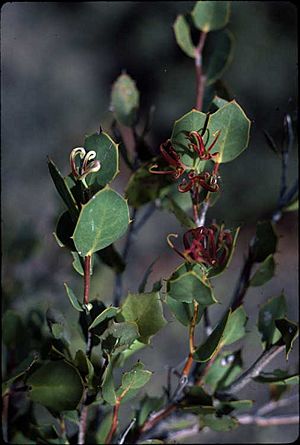Stinking Roger facts for kids
Quick facts for kids Stinking Roger |
|
|---|---|
 |
|
| Hakea denticulata south of Jerramungup | |
| Scientific classification | |
| Genus: |
Hakea
|
| Species: |
denticulata
|
 |
|
| Occurrence data from AVH | |
| Synonyms | |
|
Hakea rubriflora Lamont |
|
Stinking Roger (scientific name: Hakea denticulata) is a type of shrub that grows naturally only in southern Western Australia. It's known for its bright red flowers that bloom in spring, but it also has a strong, unpleasant smell. This plant was first described by a famous botanist named Robert Brown. It usually grows to be about 1 to 2 meters (3 to 7 feet) tall and wide.
Contents
What Stinking Roger Looks Like
Stinking Roger is a thick, woody shrub that can grow up to 1 to 2 meters (3 to 7 feet) tall and wide. Its smaller branches are covered in tiny hairs.
Leaves and Flowers
The leaves of the Stinking Roger are flat and smooth. They grow one after another along the stem. They are somewhat oval-shaped and measure about 1.5 to 4.6 centimeters (0.6 to 0.9 inches) long and 1 to 2.5 centimeters (0.4 to 1 inch) wide. The edges of the leaves have 2 to 10 small teeth, each about 1 to 2 millimeters long.
The plant produces groups of 1, 3, or 5 creamy-yellow or orange-red flowers. These flowers grow where the leaves meet the stem on the upper branches. Each flower group sits on a small stalk about 2.5 to 5.5 millimeters (0.1 to 0.2 inches) long. The flowers have a very strong, unpleasant smell. The smooth outer part of the flower is about 8.5 to 11.5 millimeters (0.3 to 0.5 inches) long. The part of the flower that receives pollen, called the style, is smooth and about 10 to 13 millimeters (0.4 to 0.5 inches) long.
Fruit and Flowering Time
After flowering, the plant produces fruits that grow at an angle from the stem. These fruits are about 23 to 28 millimeters (0.9 to 1.1 inches) long and 7 to 8 millimeters (0.3 inches) wide. They have several small prickles on their otherwise smooth surface. Stinking Roger usually flowers in July, August, September, or October.
How Stinking Roger Got Its Name
The scientific name for this plant, Hakea denticulata, was first officially written down by Robert Brown in 1830. He published his findings in a book called Supplementum primum Prodromi florae Novae Hollandiae.
Meaning of the Name
The second part of the plant's scientific name, denticulata, comes from a Latin word meaning "with small teeth." This refers to the small teeth found along the edges of the plant's leaves.
Another scientist, Byron Lamont, once gave it a different name, H. rubriflora, in 1973. He thought it was a new type of plant. However, it was later found to be the same as Hakea denticulata. Lamont's name came from the Latin words ruber (meaning "red") and flos (meaning "flower"), because of its red flowers.
Where Stinking Roger Grows
Stinking Roger is found along the southern coast of Western Australia. It grows from the city of Albany all the way east to Esperance. You can also find it further north in the Stirling Range. This plant is quite adaptable and can grow in different types of soil, including sand, gravel, and even heavier clay soil.
Growing Stinking Roger
Even though Stinking Roger has attractive leaves and flowers, its strong, unpleasant smell makes it less popular for growing in gardens.

